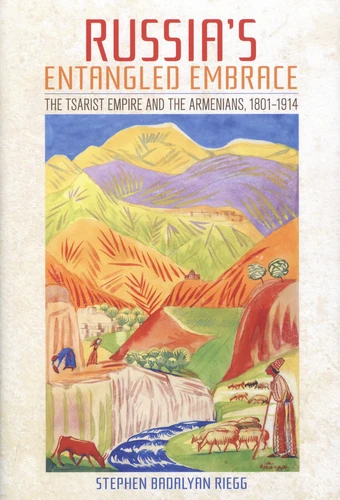Russia's Entangled Embrace. The Tsarist Empire and the Armenians, 1801-1914
Par :Formats :
- Paiement en ligne :
- Livraison à domicile ou en point Mondial Relay indisponible
- Retrait Click and Collect en magasin gratuit
- Réservation en ligne avec paiement en magasin :
- Indisponible pour réserver et payer en magasin
- Nombre de pages314
- PrésentationRelié
- FormatGrand Format
- Poids0.565 kg
- Dimensions16,5 cm × 23,1 cm × 2,3 cm
- ISBN978-1-5017-5011-3
- EAN9781501750113
- Date de parution15/07/2020
- ÉditeurCornell University Press
Résumé
Russia's Entangled Embrace traces the relationship between the Romanov state and the Armenian diaspora that populated Russia's territorial fringes and navigated the tsarist empire's metropolitan centers. By engaging the ongoing debates about imperial structures that were simultaneously symbiotic and hierarchically ordered, Stephen Badalyan Riegg helps us to understand how, for Armenians and some other subjects, imperial rule represented not hypothetical, clear-cut alternatives but simultaneous, messy realities.
He examines why, and how, Russian architects of empire imagined Armenians as being politically desirable. These circumstances included the familiarity of their faith, perceived degree of social, political, or cultural integration, and their actual or potential contributions to the state's varied priorities. Based on extensive research in the archives of St. Petersburg, Moscow, and Yerevan, Russia's Entangled Embrace reveals that the Russian government relied on Armenians to build its empire in the Caucasus and beyond.
Analyzing the complexities of this imperial relationship - beyond the reductive question of whether Russia was a friend or foe to Armenians - allows us to study the methods of tsarist imperialism in the context of diasporic distribution, inter-imperial conflict and alliance, nationalism, and religious and economic identity.
He examines why, and how, Russian architects of empire imagined Armenians as being politically desirable. These circumstances included the familiarity of their faith, perceived degree of social, political, or cultural integration, and their actual or potential contributions to the state's varied priorities. Based on extensive research in the archives of St. Petersburg, Moscow, and Yerevan, Russia's Entangled Embrace reveals that the Russian government relied on Armenians to build its empire in the Caucasus and beyond.
Analyzing the complexities of this imperial relationship - beyond the reductive question of whether Russia was a friend or foe to Armenians - allows us to study the methods of tsarist imperialism in the context of diasporic distribution, inter-imperial conflict and alliance, nationalism, and religious and economic identity.
Russia's Entangled Embrace traces the relationship between the Romanov state and the Armenian diaspora that populated Russia's territorial fringes and navigated the tsarist empire's metropolitan centers. By engaging the ongoing debates about imperial structures that were simultaneously symbiotic and hierarchically ordered, Stephen Badalyan Riegg helps us to understand how, for Armenians and some other subjects, imperial rule represented not hypothetical, clear-cut alternatives but simultaneous, messy realities.
He examines why, and how, Russian architects of empire imagined Armenians as being politically desirable. These circumstances included the familiarity of their faith, perceived degree of social, political, or cultural integration, and their actual or potential contributions to the state's varied priorities. Based on extensive research in the archives of St. Petersburg, Moscow, and Yerevan, Russia's Entangled Embrace reveals that the Russian government relied on Armenians to build its empire in the Caucasus and beyond.
Analyzing the complexities of this imperial relationship - beyond the reductive question of whether Russia was a friend or foe to Armenians - allows us to study the methods of tsarist imperialism in the context of diasporic distribution, inter-imperial conflict and alliance, nationalism, and religious and economic identity.
He examines why, and how, Russian architects of empire imagined Armenians as being politically desirable. These circumstances included the familiarity of their faith, perceived degree of social, political, or cultural integration, and their actual or potential contributions to the state's varied priorities. Based on extensive research in the archives of St. Petersburg, Moscow, and Yerevan, Russia's Entangled Embrace reveals that the Russian government relied on Armenians to build its empire in the Caucasus and beyond.
Analyzing the complexities of this imperial relationship - beyond the reductive question of whether Russia was a friend or foe to Armenians - allows us to study the methods of tsarist imperialism in the context of diasporic distribution, inter-imperial conflict and alliance, nationalism, and religious and economic identity.

